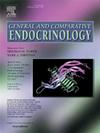In vitro effects of polycyclic aromatic hydrocarbons on sex steroid production by Arabian sea bream Acanthopagrus arabicus ovarian cells
IF 1.7
3区 医学
Q3 ENDOCRINOLOGY & METABOLISM
引用次数: 0
Abstract
Polycyclic aromatic hydrocarbons (PAHs), considered endocrine disruptors, affect the animals reproduction by interfering with the production of sex steroids. In the present study, the in vitro effects of selected PAHs (naphthalene, phenanthrene and BaP) on steroid production of cultivated ovarian cells from Arabian sea bream (Acanthopagrus arabicus) was assessed. Ovarian cells were cultured in Leibovitz L-15 (L-15) medium containing naphthalene, phenanthrene and benzo(a)pyrene with or without androstenedione (AD) as precursors and17b-estradiol (E2), progesterone (P4) and testosterone (T) were then measured. The effects of selected PAHs on the steroidogenic enzyme systems cytochrome P450 17, 20-lyase (P450-17,20l) and cytochrome P450 aromatase (P450-arom) were also compared with the ketoconazole (KCZ) action as inhibitor of cytochrome P450 steroidogenic enzymes (cytochrome P450 17, 20-lyase (P450-17,20l)) and cytochrome P450 aromatase (P450-arom). Adding exogenous androstenedione as a steroid precursor significantly increased the production of all three steroid hormones by cultured ovarian cells. On the other hand, the addition of ketoconazole significantly reduced the production of E2 and P from ovarian cells, while it had no effect on the production of T. This result showed that ketoconazole only affects the cytochrome P450 steroidogenic enzymes and has no effect on the 17-beta-hydroxysteroid dehydrogenase (17-βHSD) enzyme that convert androstenedione to testosterone. On the other hand, a significant decrease in the production of all three steroids (17β-estradiol, progesterone, and testosterone) from ovarian cells exposed to the studied pollutants (naphthalene, phenanthrene, and benzo(a)pyrene) even in the presence of androstenedione indicated that PAHs inhibit all three steroidogenic enzyme systems including P450-17,20l, P450-arom, and 17b-HSD. In conclusion, PAHs are potent inhibitors of the steroidogenic enzyme system including P450-17,20l, P450-arom, and 17b-HSD, and therefore, they can disturb the reproduction of fish living in contaminated areas due to impairment of steroid biosynthesis.
多环芳烃对阿拉伯海棘鱼卵巢细胞产生性类固醇的体外影响
多环芳烃(PAHs)被认为是内分泌干扰物,它通过干扰性激素的产生来影响动物的生殖。本研究研究了选定的多环芳烃(萘、菲和BaP)对阿拉伯海鲷(Acanthopagrus arabicus)卵巢细胞类固醇生成的体外影响。卵巢细胞在含萘、菲和苯并芘(a)芘的Leibovitz L-15 (L-15)培养基中培养,分别以或不以雄烯二酮(AD)为前体,并测定17b-雌二醇(E2)、孕酮(P4)和睾酮(T)。比较了所选多环芳烃对细胞色素P450 17,20 -裂解酶(P450-17,20l)和细胞色素P450芳香化酶(P450-arom)的影响,并比较了酮康唑(KCZ)作为细胞色素P450甾体化酶(细胞色素P450 17,20 -裂解酶(P450-17,20l))和细胞色素P450芳香化酶(P450-arom)抑制剂的作用。添加外源性雄烯二酮作为类固醇前体,可显著增加培养卵巢细胞三种类固醇激素的产生。另一方面,酮康唑的加入显著降低卵巢细胞E2和P的产生,而对t的产生没有影响。这表明酮康唑只影响细胞色素P450甾体生成酶,而对将雄烯二酮转化为睾酮的17-β -羟基类固醇脱氢酶(17-βHSD)没有影响。另一方面,即使在雄烯二酮存在的情况下,暴露于所研究的污染物(萘、菲和苯并(a)芘)的卵巢细胞中所有三种类固醇(17β-雌二醇、孕酮和睾酮)的产生也显著减少,这表明多环芳烃抑制了所有三种类固醇生成酶系统,包括P450-17、20l、p450 -芳烃和17b-HSD。综上所示,多环芳烃是P450-17、20l、P450-arom和17b-HSD等甾体生成酶系统的有效抑制剂,可以通过抑制甾体合成来干扰污染区鱼类的繁殖。
本文章由计算机程序翻译,如有差异,请以英文原文为准。
求助全文
约1分钟内获得全文
求助全文
来源期刊

General and comparative endocrinology
医学-内分泌学与代谢
CiteScore
5.60
自引率
7.40%
发文量
120
审稿时长
2 months
期刊介绍:
General and Comparative Endocrinology publishes articles concerned with the many complexities of vertebrate and invertebrate endocrine systems at the sub-molecular, molecular, cellular and organismal levels of analysis.
 求助内容:
求助内容: 应助结果提醒方式:
应助结果提醒方式:


